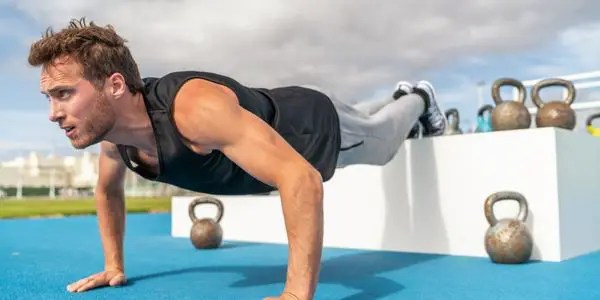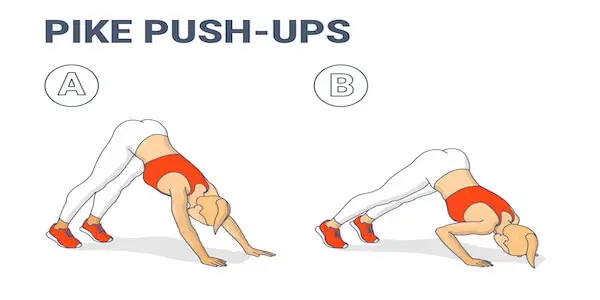If you want to add some mass and definition to your upper chest, then some targeted push-ups are the perfect exercise.
This guide will discuss everything you need to know about mastering upper chest push-ups.
We’ll talk about the mechanics of this exercise, variations you can try, and tips that will help you get the most out of your workouts.
Table of Contents
How to Target Your Upper Chest with Push-Ups
Understanding the mechanics of targeting your upper chest with push-ups is essential because:
- You can imagine countless push-up variations and exercises targeting these muscles.
- You can adapt the variations discussed below according to your fitness level and scale up later.
So, to target your upper chest with push-ups, you need to exercise a larger force on them.
That means either using a weighted vest or other weights to push on your upper chest OR creating that force with your body.
How do you do that?
- Increase the angle between your chest and the floor so that your upper chest has to lift more weight.
- Increase the angle between your arms and your body to create additional force working on the sides of your upper chest.
- Increase the range of motion by pulling your shoulders back or wearing resistance bands above your elbows to give you more support.
4 Best Push-Ups for Upper Chest
Now that you know the mechanics behind push-ups for the upper chest, let’s see them at play with real-life examples:
1. Decline Push-Up

The decline push-up is a good exercise to work your upper chest muscles because it elevates your feet, so your upper chest will have to lift more weight.
Here’s how to do it:
- Place your feet on an elevated surface and your hands on the ground.
- Lower yourself down until your chest is just above the ground.
- From here, push back up to the starting position.
Tips and tricks:
- If you want to make this exercise more challenging, wear a weighted vest.
- If you want to make it easier, you can do it from your knees or use a shorter box.
- To get even more work out of your upper chest muscles, use a stability ball or Bosu ball instead of a fixed surface to elevate your legs. Alternatively, place your feet on a higher box.
- Remember to keep your form strict when doing this exercise so you don’t injure yourself.
2. Pike Push-Up

Most people are familiar with traditional push-ups, but the pike push-up is a variation that offers several benefits.
The key difference between a pike push-up and a conventional push-up is that your body forms an inverted V shape during the pike push-up. This position engages different muscle groups and can improve shoulder stability and mobility. In addition, pike push-ups are a great way to build upper chest strength because:
- You will have a narrower grip.
- The angle between your upper chest and the floor is larger than a standard push-up.
As a result, your upper chest will have to press against a higher force that this position creates artificially.
Here’s how to do it:
- Start in the plank position with your hands shoulder-width apart and your feet hip-width apart.
- Then, keeping your core engaged, bend at the hips to create an inverted triangle.
- Bend your elbows to move your head down diagonally.
- Press back up to complete one rep.
Tips and tricks:
- You can make this exercise more challenging by wearing a weighted vest or placing your feet on an elevated surface.
- If you want to make it easier, try doing pike push-ups from your knees.
- Remember to pull your shoulders back so that your upper chest has to work harder.
3. Wide Grip Push-Up

A wide-grip push-up is an excellent exercise for targeting the upper chest because of the wide grip:
- Recruits more of the pec muscles, specifically the pectoralis major, which is responsible for the size and shape of the chest.
- Helps stretch the pecs, which can lead to increased muscle growth.
Here’s how to do it:
- Start in the plank position with your hands shoulder-width apart and your feet hip-width apart.
- Then, place your hands wider than shoulder-width apart.
- Lower yourself down until your chest is just above the ground.
- From here, press back up to the starting position.
Tips and tricks:
- If you want to give your upper chest even more challenge, pull your shoulders back. You can also use a Bosu ball for those feet or elevate your feet.
- To make it easier, place your hands on an elevated surface or even a wall.
4. Elevated Archer Push-Up

The Archer push-up primarily targets your lower chest because one hand is near your body while the other is straight. However, you can adapt this variation to target your upper chest by increasing the angle.
And that means lifting your feet off the ground.
Here’s how to do it:
- Start in a standard plank position from your hands, with your feet elevated on a Plyo box.
- Keep the left hand under the left shoulder, bending the left elbow until the right arm is straightened.
- Lift your body by doing an arch-like movement to the right.
- That’s one rep. Do 8-12 reps before taking a break.
Tips and tricks:
- You can place more emphasis on your upper chest muscles by lifting your feet more or by using a Bosu ball.
- You can make this exercise easier by using a shorter box and doing the push-ups from your knees.
Creating a Well-Rounded Routine for the Upper Chest
Now that you’re here, you know which type of push-ups can strengthen and sculpt your upper chest muscles best. And if you understand the mechanics behind these exercises, you can now create different variations according to what your body can do today.
But remember that you need a well-rounded routine for your upper chest to achieve the best results.
That includes other exercises for the whole chest, core, arms, and upper back. Those strong upper chest muscles must be connected to other strong muscles.
So consider using gym equipment like the pec deck or chest fly machine if you have a gym membership. Alternatively, consider a spin bike with added resistance bands or free weights for your home gym.
Basically, the world is your oyster so start experimenting today.
- What Happens To Your Body When You Do Dips Every Day - June 28, 2024
- 9 Push-Up Mistakes You Might Be Making (And How to Fix Them) - October 10, 2022
- The Complete Guide to Mastering Upper Chest Push Ups - October 10, 2022

